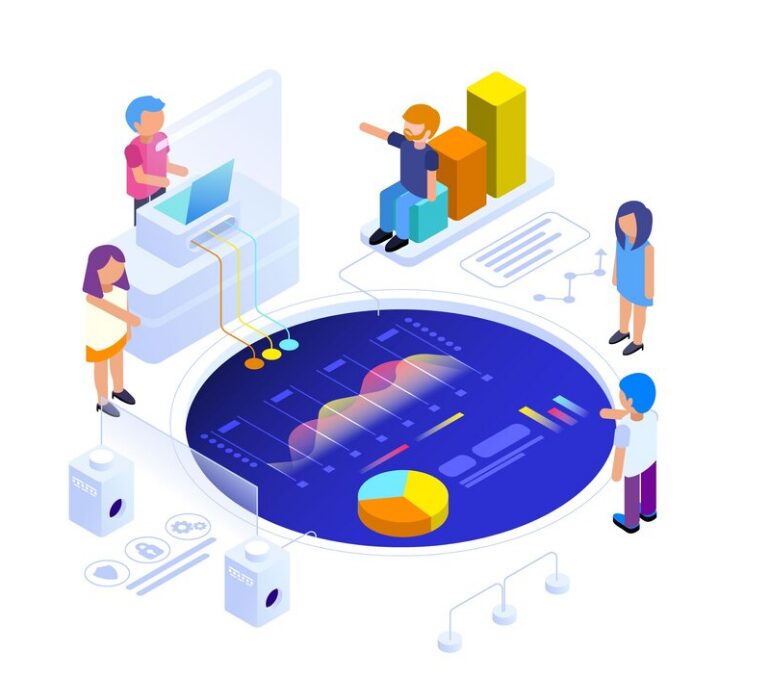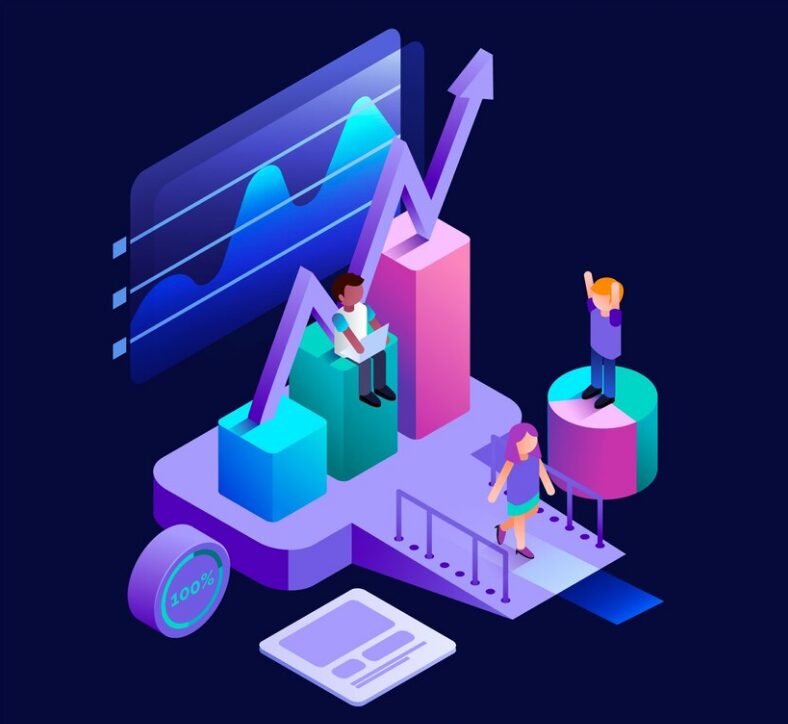If you’re reading this, you likely know that data analytics have become increasingly critical in today’s digital age. Advanced data analytics, in particular, has the potential to generate powerful insights that can inform critical business decisions. By leveraging data analysis techniques and predictive analytics, businesses can gain a deeper understanding of their operations, customer behavior, and market trends. In this article, we’ll explore the world of advanced data analytics and highlight the latest techniques to help you unlock your data’s full value.
Table of Contents
Understanding Advanced Data Analytics
Advanced data analytics is the process of using complex tools and techniques to analyze and interpret large data sets. It differs from traditional data analytics in that it delves deeper and extracts more valuable insights.
The term big data analytics refers to the practice of analyzing large and complex data sets, including structured and unstructured data. Machine learning is a subfield of artificial intelligence that utilizes algorithms to analyze big data and extract insights.
The benefits of implementing advanced data analytics in today’s digital age are numerous. It enables businesses to gain insights into market trends, customer behavior, and operational efficiency, among other things. However, it also poses significant challenges, including the need for high computational power and skilled personnel.
| Pros | Cons |
|---|---|
| Ability to extract insights from large data sets | Requires high computational power |
| Improved decision-making and strategic planning | Requires skilled personnel |
| Identifies patterns and trends in customer behavior | May pose privacy and security risks |
Big Data Analytics
Big data analytics refers to the process of analyzing large, diverse, and complex data sets to gain insights and knowledge that can be used to make informed decisions. Big data analytics involves the use of advanced algorithms to uncover patterns and relationships within data sets.
Big data analytics is essential in today’s digital world, where data is gathered from a variety of sources, including social media, mobile devices, and the Internet of Things (IoT).
Machine Learning
Machine learning is a subfield of artificial intelligence that involves the use of algorithms to analyze big data sets. Machine learning models learn from the patterns in the data and use them to make predictions or classifications.
Examples of machine learning applications include image recognition, speech recognition, and predictive analytics.
When integrated into advanced data analytics, machine learning algorithms can help businesses identify patterns and trends that would be impossible for humans to detect. This helps improve decision-making processes and allows businesses to stay ahead of the competition.
Data Analysis Techniques for Advanced Analytics

As businesses continue to generate an overwhelming amount of data, advanced analytics has become an integral part of deriving meaningful insights. Data analysis techniques play a critical role in this process, allowing organizations to transform raw data into actionable insights.
Data Mining Methodologies
Data mining is the process of identifying patterns and associations within large datasets. By utilizing specialized software and algorithms, businesses can analyze vast amounts of data to extract valuable insights. This can include anything from customer behavior patterns to forecasting future trends.
One popular data mining technique is cluster analysis, which involves grouping data points based on their similarities. This enables businesses to segment their customer base and identify key trends within each group. Another commonly used technique is regression analysis, which can help organizations identify the relationships between different variables, such as the impact of price changes on customer demand.
Predictive Modeling:
- Predictive modeling is a powerful data mining methodology used for forecasting future outcomes based on historical data. By creating mathematical models that predict trends, businesses can make informed decisions and strategize for the future. This technique is particularly valuable in industries where anticipating market shifts is critical.
Association Rule Learning:
- Association rule learning, commonly known as association analysis or market basket analysis, identifies relationships between variables in large datasets. This is often employed in retail settings to uncover purchasing patterns—revealing which products are frequently bought together. Such insights empower businesses to optimize product placements and marketing strategies.
Text Mining:
- Text mining involves extracting valuable information and patterns from unstructured text data, such as customer reviews, social media comments, and surveys. This methodology utilizes natural language processing algorithms to analyze textual content, providing businesses with a deeper understanding of customer sentiments and preferences. Text mining is instrumental in shaping effective communication and branding strategies.
Time Series Analysis:
- Time series analysis is a data mining approach that focuses on understanding patterns within chronological data points. By examining historical trends over time, businesses can identify seasonal fluctuations, forecast future trends, and optimize resource allocation. This methodology is particularly useful in industries where time plays a crucial role, such as finance and inventory management.
Data mining methodologies offer diverse tools to unearth meaningful insights from complex datasets. Whether through predictive modeling, association rule learning, text mining, or time series analysis, businesses can leverage these techniques to enhance decision-making, refine marketing strategies, and gain a competitive edge in today’s data-driven landscape.
Statistical Analysis Tools
Statistical analysis is a critical aspect of advanced analytics, providing a framework for assessing the significance of data. This involves using mathematical models to analyze patterns and relationships within data.
Some of the most widely used statistical techniques include hypothesis testing, which involves testing a theory or assumption against a sample dataset, and correlation analysis, which measures the strength of a relationship between two variables. In addition, machine learning algorithms are increasingly being used to identify patterns within datasets, enabling businesses to make more accurate predictions and decisions.
| Data Analysis Technique | Description |
|---|---|
| Data Mining | Identifies patterns and associations within large datasets |
| Regression Analysis | Identifies relationships between variables, such as price changes and demand |
| Hypothesis Testing | Tests a theory or assumption against a sample dataset |
| Correlation Analysis | Measures the strength of a relationship between two variables |
| Machine Learning | Identifies patterns and makes predictions using algorithms |
By utilizing data analysis techniques such as data mining and statistical analysis, businesses can extract valuable insights from their data. These insights can be used to optimize operations, improve customer experiences, and gain a competitive edge in today’s digital age.
Harnessing the Power of Predictive Analytics

In today’s business landscape, predictive analytics has become an essential tool for decision-making. By analyzing historical data through machine learning algorithms, businesses can accurately predict future outcomes and optimize their processes for better performance.
Moreover, predictive analytics helps organizations to identify trends, understand customer behaviors, and gain insights into market opportunities. It also helps businesses to reduce risks and minimize uncertainties by leveraging data-driven strategies.
By implementing predictive analytics tools and techniques, you can stay ahead of the competition and unlock the full potential of your data. With the ability to make informed decisions quickly, your business can increase its profitability, improve customer satisfaction, and drive growth.
The Role of Data Visualization in Advanced Analytics
In advanced analytics, data visualization is an essential tool for gaining actionable insights. Rather than sifting through mountains of raw data and spreadsheets, data visualization techniques and tools enable businesses to present complex data sets in a more accessible and understandable format that is easy to interpret and analyze.
Data visualization involves creating visual representations, such as graphs, charts, and heatmaps, that allow you to see patterns, trends, and relationships that might not be immediately evident in raw data. By presenting data in a visual format, you can quickly identify outliers, detect correlations, and communicate complex ideas more effectively.
The Importance of Choosing the Right Visualization Techniques
When choosing visualization techniques, it is important to consider the nature of the data you are working with and the message you want to convey. Line charts, for example, are perfect for showing trends over time, while pie charts are useful for highlighting proportions.
The choice of color schemes, labeling, and layout can also impact the effectiveness of data visualization. By selecting colors that are easy to distinguish, fonts that are easy to read, and well-organized layouts, you can create visualizations that are not only informative but also visually engaging.
| Visualization Technique | Best Use |
|---|---|
| Line Chart | Trends over time |
| Pie Chart | Highlighting proportions |
| Bar Chart | Comparing values |
| Heatmap | Identifying patterns in large data sets |
The Benefits of Data Visualization in Business
The benefits of data visualization extend beyond the realm of analytics to a wide range of business functions. By presenting data in a visual format, businesses can communicate complex information more effectively, facilitate collaboration and decision-making, and reveal actionable insights that might otherwise be hidden.
Data visualization also makes it easier to tell a story with data, adding context and meaning to raw numbers and figures. By combining visualizations with narrative and other forms of context, businesses can create compelling and persuasive data-driven stories that resonate with stakeholders, whether they are executives, investors, or customers.
Integrating Business Intelligence Tools for Advanced Data Analytics

Business intelligence (BI) is a powerful technology that enables businesses to transform raw data into meaningful insights to drive informed decision-making. Integrating BI tools into advanced data analytics allows you to visualize data trends, generate interactive reports, and monitor key performance indicators to optimize business processes.
BI tools like Tableau, Microsoft Power BI, and SAP BusinessObjects are widely used in advanced data analytics. These tools allow you to connect with multiple data sources, explore data sets, and analyze complex relationships between different data points. By integrating BI tools into your data analytics workflows, you can generate visually appealing reports that help to communicate insights effectively.
Benefits of integrating BI tools for advanced data analytics
Integrating BI tools into advanced data analytics offers several benefits, including:
- Improved data visualization: BI tools enable you to present data trends and insights in an easy-to-understand visual format, making it easier for you to communicate insights to a non-technical audience.
- Enhanced decision-making: BI tools allow you to access real-time data, giving you the ability to make informed decisions that drive business success.
- Reduced manual effort: BI tools automate data processing tasks such as report generation, freeing up your team’s time to focus on more strategic tasks.
Challenges of integrating BI tools for advanced data analytics
However, integrating BI tools into advanced data analytics also comes with its own set of challenges, including:
- Data integration: BI tools require data from multiple sources to generate meaningful insights. Integrating data from different sources can be challenging, especially when there is a lack of data consistency.
- Cost: BI tools can be expensive, especially when you opt for enterprise-grade solutions. Ensuring a positive ROI is crucial when considering integration.
- Data security: BI tools require access to sensitive business data, making it important to ensure that the solution used is secure and complies with data privacy regulations.
To conclude,
Integrating BI tools into advanced data analytics is crucial for businesses that want to make informed, data-driven decisions. Although integrating BI tools can be challenging, the benefits outweigh the drawbacks. By using the right tools and implementing effective data management processes, you can transform your raw data into meaningful insights that can help your business grow.
Overcoming Challenges in Advanced Data Analytics
Implementing advanced data analytics is crucial to gain in-depth insights and make data-driven decisions. However, it comes with its challenges. Here are the common obstacles faced by organizations in utilizing big data analytics and strategies for overcoming them:
1. Lack of Skilled Workforce
One of the significant challenges is the shortage of skilled professionals who can handle advanced data analytics. It requires a set of specialized skills such as statistical analysis, predictive modeling, and machine learning. Organizations can bridge this gap by providing training and development opportunities to their employees and partnering with specialized data analytics service providers.
2. Data Integration
Incorporating data from various sources into a single usable format is complex. When dealing with large volumes of data from multiple sources, it becomes challenging to integrate, verify, and organize that data. A solution is using data integration tools that can automate parts of this process while also providing robust data governance controls.
3. Quality of Data
The quality of the data is another critical challenge to successful data analytics. Incomplete, incorrect, or inconsistent data can undermine analytical insights. Organizations can ensure data quality by implementing data governance policies such as standardization of data formats and enforced data validation procedures.
4. Data Security and Privacy
With the increasing amount of data being shared across organizations, data security and privacy are paramount. Companies must adopt best practices such as encryption, access controls, and secure data storage solutions that adhere to regulatory compliance.
5. Cost of Implementation
Integrating advanced data analytics into traditional business processes can be prohibitively expensive. However, the benefits of advanced analytics, such as increased revenue and operational efficiency, make it a worthwhile investment. Organizations can start small and scale their efforts by focusing on critical business areas where analytics can generate maximum impact.
Future Trends in Advanced Data Analytics
Advanced data analytics has come a long way since its inception. As data volumes continue to accelerate, so do the opportunities and trends within the field. Here are some emerging trends that are set to shape the future of advanced data analytics:
Integration of Predictive Analytics
Predictive analytics provides insights into future trends and behaviors, enabling businesses to make proactive and well-informed decisions. By integrating predictive analytics into their advanced data analytics framework, businesses can harness its power to optimize their operations and stay ahead of the curve.
Advancements in Data Visualization Techniques
Data visualization plays a crucial role in making data more accessible and understandable. With advancements in artificial intelligence and machine learning, data visualization tools are becoming more sophisticated, enabling businesses to present complex data sets in a more engaging and visually appealing format. This trend is set to continue, making it easier for businesses to extract insights from their data.
Increased Collaboration and Data Sharing
The ability to collaborate and share data with other organizations is a growing trend in advanced data analytics. By sharing data and resources, businesses can leverage collective insights and expertise to optimize their decision-making processes. Increased collaboration and data sharing will be key to unlocking the full potential of advanced data analytics.
The future of advanced data analytics is exciting and full of opportunities. By keeping up with emerging trends, businesses can stay ahead of the curve in a rapidly changing digital landscape.
Conclusion
You now have a solid understanding of the power of advanced data analytics and the importance of leveraging data analysis techniques. By harnessing the power of predictive analytics and using business intelligence tools, you can unlock valuable insights and make data-driven decisions that drive growth and profitability.
Remember to stay informed about emerging trends, such as advancements in data visualization techniques, to stay ahead of the competition and make the most of your data. With the right tools and strategies in place, you can take your business to the next level with advanced data analytics.
Thank you for reading and we hope you found this guide informative and helpful. If you have any questions or would like to learn more about advanced data analytics, please don’t hesitate to contact us.





Permalink